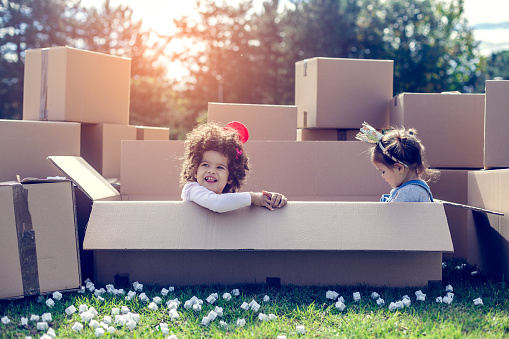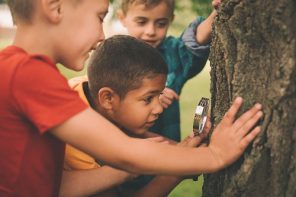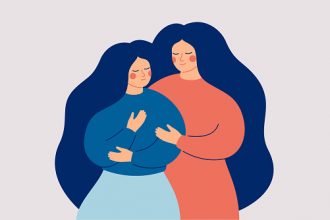Angel begins to bang on a variety of pots and pans. He arranges traditionally-carved wooden bowls donated to the classroom by families alongside cardboard boxes and listens as he bangs on them, experimenting with different sounds by using metal and wooden utensils. He tells Marina, who is sitting next to him, “This is how my dad drums when we go to see my family.”
Angel is a member of the Miwok community, where drumming is part of gatherings and ceremonies. Joaquin joins in and starts singing a familiar song in Spanish, his home language. He bangs along with Angel as he sings and other children join in—and together, they learn about each other’s cultures.
This is just one example of what “loose parts play,” can look like in a classroom that focuses on creating culturally sustainable environments.
That same week, Aki’s grandmother, who is Japanese, showed the children how to use a scarf to create a bag—also known as the ancient Japanese art of furoshiki. This moment led to a conversation about not using plastic bags when going to the market.
Playtime as Serious Learning
British architect Simon Nicholson originally coined the term “loose parts. He believed that it is the loose parts in our environment that empower creativity. In a school setting, loose parts are materials that can be moved, combined, lined up, taken apart and put back together in multiple ways.
Gloria Ladson-Billings, American pedagogical theorist and teacher educator first introduced the idea of culturally-sustainable environments. Ladson-Billings argued that to create equality and equity in education, we need to produce students who…
- Can achieve academically
- Feel comfortable talking about their own culture
- Understand and critically question societal rules and norms
By combining these two ideas—loose parts and culturally-sustainable environments—you can support children’s learning, development and a sense of both individual and group identity. We often don’t think of playtime as “serious learning,” but when you incorporate these two ideas, children benefit in so many ways.
Learning Through Symbolic Play
Because loose parts lend themselves to being manipulated in a variety of ways, they may support the development of something called symbolic play. Symbolic play is the ability to use objects, actions or ideas to represent other objects, actions or ideas.
When children play “cooking” by using loose parts (such as stones, beads, pots and dishes from their culture), they learn that each culture may use different tools and utensils to prepare food.
Creative and Critical Thinking Skills
These skills are essential to the process of learning, assessing what we learn and functioning in a global society. When children use loose parts, they can generate ideas about differences and similarities, and gain appreciation for diversity.
Critical thinking empowers children to fully participate in creating environments that promote equality and equity and embrace social justice.
Learning About Each Other and Respecting Differences
When children engage in “loose parts play,” their culture, history, language, traditions and values are respected and honored. This creates a sense of belonging which allows children to be their authentic selves—curious and ready learn about each other.
These are skills they will need to function in the future, where they will have to positively engage and build equal relationships with diverse groups of people.
Developing and Demonstrating Empathy
Empathy is an essential trait that helps us make meaningful connections with others in both our work and personal lives. Empathy requires the ability to suspend judgment and to listen and understand another person’s feelings.
The open-ended nature of loose parts gives children opportunities to take on unfamiliar roles, which allows them to see different perspectives. As a result, they begin to develop a better understanding of other people’s thinking and to respond with empathy. See how to help your child where bullying is common.
Growing Towards Equality and Equity
Brazilian educator and philosopher Paulo Freire once said that when children use critical thinking to question unfairness, they are actively participating in “the practice of freedom; the means by which men and women deal critically and creatively with reality and discover how to participate in the transformation of their world.”
Since children are in control of the loose parts, they develop comfortable, empathetic and just interactions with diversity. As they negotiate in their play, they develop the skills for standing up for themselves and others in the face of injustice.
Promoting Democracy
When educators and families create environments that respect children’s cultures, language, history and traditions, children feel free to express themselves. This allows students to fully participate in a democratic process.
Loose parts involve children directly in making collaborative decisions, testing ideas and sharing their experiences with other children. In this way, they are beginning to engage in participatory democracy.
Supporting Children’s Strengths
Children are capable and competent. They are driven by an intense sense of curiosity. Educators and families can build on children’s strengths by infusing loose parts into the environment and giving children time to freely explore, test different ideas and make mistakes.
Assuming Responsibility for the Environment
Because loose parts are often recycled or up-cycled items, they can support ecological sustainability. They can also teach children the responsibility to maintain future environments.
Children can learn that you don’t always need to purchase items. Instead, they actively understand that recycling helps sustain the environment and preserve it for future generations.
So much of today’s childhood is structured. Everywhere you look, there are games and toys with strict rules, with no room for deviation. We invite you to design environments that allow children to take risks, develop relationships and test their ideas.
Create spaces where children feel a sense of belonging and can explore who they can be in the future. And invest in building places where children can wonder, be joyful, investigate their identity and build interconnected relationships.
Miriam Beloglovsky and Lisa Daly are the co-authors of several books, including Loose Parts 3: Inspiring Culturally Sustainable Environments, and Early Learning Theories Made Visible. They are both professors of early childhood education in Sacramento, Calif.





